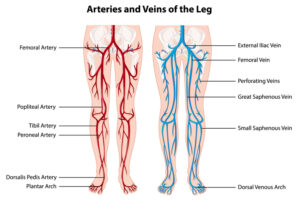Genicular Arteries Normal Anatomy and Anatomical Variants
The genicular arteries are a network of arteries around the knee joint that contribute to the blood supply of the knee. Understanding these variations in the anatomy of genicular arteries is important in clinical practice, particularly in procedures such as angiography, arterial interventions, and surgical approaches to the knee joint. Knowledge of variant anatomy helps healthcare professionals anticipate potential challenges and complications and adapt their approach accordingly.

Origin: The genicular arteries arise from various branches of the femoral artery, popliteal artery, and the descending genicular artery.
- Branches: The genicular arteries have several branches that form an intricate network around the knee joint. These branches include the superior medial genicular artery, superior lateral genicular artery, middle genicular artery, inferior medial genicular artery, and inferior lateral genicular artery.
- Distribution: These arteries distribute blood to different regions of the knee joint. The superior medial and lateral genicular arteries supply blood to the proximal part of the knee joint, including the femur and surrounding tissues. The middle genicular artery supplies blood to the synovial membrane within the joint capsule. The inferior medial and lateral genicular arteries provide blood to the distal part of the knee joint, including the tibia and fibula.
- Anastomoses: The genicular arteries form numerous anastomoses (connections) with each other and with other arteries around the knee joint, such as the descending genicular artery, circumflex femoral arteries, and the anterior and posterior tibial arteries. These anastomoses create redundant pathways for blood flow, ensuring adequate perfusion of the knee joint even if one artery is compromised.
Variants of genicular arteries anatomy
Variants in the anatomy of genicular arteries are not uncommon and can include variations in their origin, course, branching pattern, and distribution. Here are some common variants:
- Additional branches: Variations can occur in the number and origin of branches of the genicular arteries. While the main branches typically include the superior medial, superior lateral, middle, inferior medial, and inferior lateral genicular arteries, additional branches or variations in their origins may be present.
- Absent or hypoplastic branches: In some individuals, one or more branches of the genicular arteries may be absent or significantly reduced in size (hypoplastic). This variation may not necessarily affect the overall blood supply to the knee joint but could influence the collateral circulation in cases of arterial occlusion or injury.
- High origin: Sometimes, the genicular arteries may have a higher origin than usual. For example, the superior medial genicular artery might arise directly from the femoral artery rather than from the popliteal artery.
- Low origin: Conversely, the genicular arteries may have a lower origin than usual. This could involve branches originating from arteries below the typical level, such as the descending genicular artery or the anterior tibial artery.
- Anomalous branches: Occasionally, anomalous branches or connections may be present, leading to variations in the arterial supply to specific regions of the knee joint. These anomalies may not follow the typical pattern observed in most individuals.
- Crossing branches: Some genicular arteries may exhibit crossing branches, where arteries from different sources intersect or overlap within the knee joint region. These crossings can create unique vascular patterns and potential points of vulnerability or collateral circulation.
- Variant pathways: In addition to variations in branching patterns, there can be differences in the pathways taken by the genicular arteries as they supply blood to different regions of the knee joint. These variant pathways may reflect adaptations to individual anatomy or developmental anomalies.
Contact us today to learn more about the complex vascular system of the knee joint and how it may impact your overall health. Our team of experts at Premier Vein and Vascular Center specializes in diagnosing and treating vascular conditions, helping you maintain optimal blood flow and function in all areas of your body. Don’t let potential anomalies or variations in your genicular arteries go unnoticed – schedule a consultation with us today.
